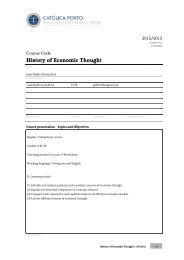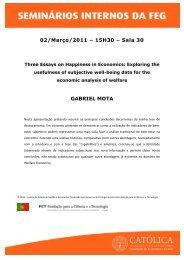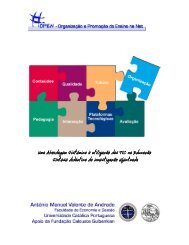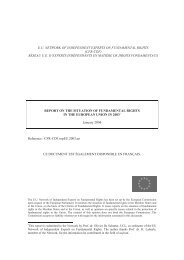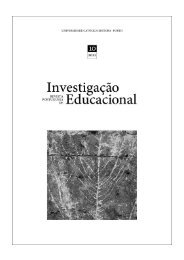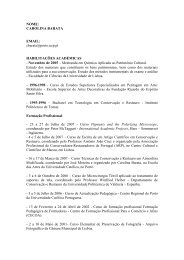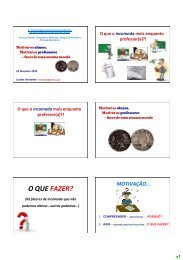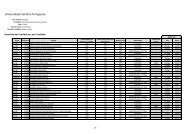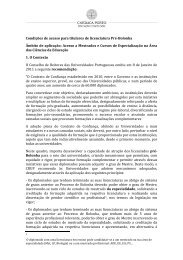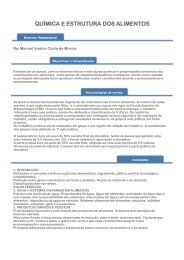Peer and Self evaluation strategies – a start
Peer and Self evaluation strategies – a start
Peer and Self evaluation strategies – a start
You also want an ePaper? Increase the reach of your titles
YUMPU automatically turns print PDFs into web optimized ePapers that Google loves.
<strong>Peer</strong> <strong>and</strong> <strong>Self</strong> assessment <strong>strategies</strong> <strong>–</strong> a <strong>start</strong>!<br />
This gives a <strong>start</strong>ing point for cataloguing <strong>strategies</strong> which promote peer <strong>and</strong> self assessment. Please feel free to add <strong>and</strong> select!<br />
NB. Tasks listed under ‘<strong>Self</strong>-<strong>evaluation</strong>’ are usually done as an individual task; however, many can be done with a partner <strong>and</strong>/or in a group. Several tasks<br />
could fit under more than one heading …feel free to move them around!<br />
SELF EVALUATION TASKS<br />
A: Personal reflection<br />
Strategy Key Benefit(s) Notes + Example of how <strong>and</strong> where it could be used in a<br />
lesson<br />
1 Reflection / <strong>Self</strong> assessment <strong>–</strong><br />
generic prompt questions<br />
•This helps the student to focus<br />
on specific aspects of learning<br />
<strong>and</strong> means that they don’t miss<br />
anything out<br />
•This provides the student with<br />
a scaffold to guide their<br />
reflections<br />
•After a key summative assessment point, students are given a self<br />
assessment prompt sheet to reflect on their performance <strong>and</strong> to<br />
identify areas of strength <strong>and</strong> weakness, They could also be asked to<br />
highlight topic areas with which they struggle<br />
2 Reflection time •This forces students to think<br />
about their learning <strong>and</strong> their<br />
progress. Review <strong>and</strong> reflection<br />
are essential for authentic<br />
learning <strong>and</strong> need to be<br />
planned for<br />
4 Reflection <strong>–</strong> pre <strong>and</strong> post task This allows for students to<br />
demonstrate prior learning <strong>and</strong><br />
it enables them to create a<br />
baseline from which they can<br />
measure progress<br />
•In the middle of an Art project, students reflect on their own work<br />
against the stated learning outcome <strong>and</strong> revise their plans. They also<br />
have the opportunity to ask for support.<br />
•At the <strong>start</strong> of a unit of work on Oppenheimer, students make a note<br />
of anything <strong>and</strong> everything they know about Oppenheimer. They<br />
review their notes at the end of the unit of work <strong>and</strong> check to see how<br />
accurate they were <strong>and</strong> what they’ve learned in the meantime<br />
MG Simpson / JE Lovely <strong>–</strong> Updated: April, 2005 - Page 1
Strategy Key Benefit(s) Notes + Example of how <strong>and</strong> where it could be used in a<br />
lesson<br />
5 Ratings •This is a quick visual prompt<br />
<strong>and</strong> way of a student reflecting<br />
on where they are at the <strong>start</strong><br />
<strong>and</strong> end of a learning episode<br />
•At the <strong>start</strong> of a unit of work, students reflect on their level of ability:<br />
Subtraction<br />
Can’t do 1-2-3-4-5-6-7-8-9-10 can do<br />
Excellent for measuring success <strong>and</strong> raising self esteem …also, builds<br />
in accountability for progression<br />
B: Quick non-verbal reflection<br />
Strategy Key Benefit(s) Notes + Example of how <strong>and</strong> where it could be used in a<br />
lesson<br />
1 Teacher asks students for their<br />
level of confidence<br />
•Students can identify productive<br />
areas on which to focus their efforts<br />
<strong>and</strong> develop mastery of particular<br />
•Students respond by st<strong>and</strong>ing / sitting / sitting on the floor<br />
depending on their level of confidence with a task<br />
concepts <strong>and</strong> skills<br />
2 Thumbs up / H<strong>and</strong>s up •This is a very quick diagnostic for the<br />
teacher to assess levels of confidence<br />
<strong>–</strong> if the teacher wants to protect the<br />
students, they can make their<br />
indications with their eyes closed, so<br />
it is only the teacher who sees the<br />
judgement<br />
3 Traffic light cards •Another quick visual diagnostic for<br />
the teacher …<strong>and</strong> also a means by<br />
which students can voice an opinion<br />
as to their level of underst<strong>and</strong>ing<br />
•At the end of the lesson, a PE teacher conducts a plenary review of<br />
the main objectives of the lesson with students indicating with<br />
thumbs up/down or h<strong>and</strong>s wavering in the middle as to whether they<br />
believe they met the objectives …they then discuss one thing they<br />
could do next time to improve with a partner on the way back to the<br />
changing rooms …telling the teacher as they leave for their next<br />
lesson<br />
•At the <strong>start</strong> of a Science lesson, students are asked a key question<br />
<strong>and</strong> they respond to the question by raising red/amber/green cards<br />
as to whether they could answer the question with confidence.<br />
Throughout the lesson, the students leave the card on their table,<br />
changing the card as the lesson progresses (turning the red card<br />
face up if they don’t underst<strong>and</strong> something at all …<strong>and</strong> turning the<br />
green card over when they feel confident enough to answer the<br />
MG Simpson / JE Lovely <strong>–</strong> Updated: April, 2005 - Page 2
Strategy Key Benefit(s) Notes + Example of how <strong>and</strong> where it could be used in a<br />
lesson<br />
question. The task is repeated at the end of the lesson.<br />
C: Creating own assessments <strong>and</strong> marking<br />
Strategy Key Benefit(s) Notes + Example of how <strong>and</strong> where it could be used in a<br />
lesson<br />
1 Use examples of work from<br />
anonymous students <strong>and</strong><br />
ask their peers to suggest<br />
•Students see what success looks like <strong>and</strong><br />
explicitly identify the features that make for<br />
a good piece of work<br />
•Students are give some solutions to a problem <strong>and</strong> asked to<br />
evaluate the efficiency of the <strong>strategies</strong> chosen, to identify errors<br />
<strong>and</strong> make suggestions for improvement<br />
ways of improving the work •Helps moderate shared underst<strong>and</strong>ing of •Students are given some background <strong>and</strong> results from a<br />
<strong>and</strong> how they would meet st<strong>and</strong>ards<br />
particular scientific enquiry <strong>and</strong> a set of results. Before writing their<br />
the learning outcomes •Sets benchmarks for target setting<br />
conclusion of the enquiry, pupils are shown examples written by<br />
other pupils <strong>and</strong> discuss which is the better conclusion <strong>and</strong> why<br />
•The teacher uses a piece of work that is not perfect but is about<br />
the st<strong>and</strong>ard that the pupils might achieve. Pupils work in groups,<br />
using the criteria to agree the level<br />
2 Students evaluate their own<br />
answers<br />
3 Students develop<br />
assessment criteria<br />
4 Ask students to write their<br />
own questions on a topic to<br />
match the expected<br />
learning outcomes <strong>and</strong>, in<br />
•This enables students to reflect objectively<br />
on their work <strong>–</strong> it is most effective when<br />
there is a time-lag between the completion<br />
of the work <strong>and</strong> the reflection point. This is<br />
also more effective if the student uses<br />
assessment criteria as a checklist<br />
•This helps students to get into the whole<br />
assessment process <strong>–</strong> it focuses them on<br />
the process of knowing what<br />
information/skill needs to be assessed <strong>and</strong><br />
then devising the means to assess it<br />
•Helps students distinguish between<br />
learning objectives <strong>and</strong> learning outcomes<br />
(<strong>and</strong> how to ‘come up with the goods’)<br />
•Helps students recognise a range of<br />
•Before h<strong>and</strong>ing in a piece of persuasive writing, students review<br />
their own work <strong>and</strong> suggest the grade they believe they should<br />
receive for the work <strong>and</strong> they identify the evidence to back up their<br />
judgement<br />
•Students in Music are asked to create an assessment task for<br />
their colleagues who will demonstrate that they can compose 12-<br />
bar blues. They have to identify the assessment criteria …<strong>and</strong> in<br />
so doing, have to identify the essential ingredients for themselves<br />
•At the end of a topic of work, students generate their own end of<br />
topic ‘test’, with mark schemes using the expected outcomes for<br />
that topic <strong>and</strong> their own books <strong>and</strong> textbooks as a resource …their<br />
peers have to complete the tests<br />
MG Simpson / JE Lovely <strong>–</strong> Updated: April, 2005 - Page 3
Strategy Key Benefit(s) Notes + Example of how <strong>and</strong> where it could be used in a<br />
lesson<br />
addition, provide answers to<br />
others’ questions<br />
alternative appropriate responses<br />
D: Graphic Organisers<br />
Strategy Key Benefit(s) Notes + Example of how <strong>and</strong> where it could be used in a lesson<br />
1 Traffic lights • Very effective strategy for<br />
seeing improvement <strong>and</strong><br />
for targeting specific<br />
areas of concerns …<br />
rather than focusing on<br />
everything, the ‘red’ areas<br />
can be dealt with<br />
systematically. It is an<br />
excellent ‘dipstick’ for staff<br />
too as it is easy to see. It<br />
avoids the trials of writing<br />
self assessments <strong>and</strong> is<br />
more fun!<br />
•The teacher asks students to ‘traffic light’ concepts for a particular piece of work. Green<br />
is ‘happy’; amber is ‘not quite sure’; <strong>and</strong> red is ‘very unsure’. Work can then be targeted<br />
at an appropriate level <strong>–</strong> OR - Greens can then support ambers <strong>and</strong> reds. Many red<br />
marks mean more in-depth teaching is required.<br />
•Allows students to give an immediate response in a secure environment<br />
2 Webs / Mind maps<br />
/ Concept maps<br />
•Lots of information can be<br />
summarised very succinctly.<br />
They can also be used for<br />
giving students ‘the ‘BIG’<br />
picture at the <strong>start</strong> of a unit<br />
<strong>and</strong> then students can ‘traffic<br />
light’ the web / map at the end<br />
of the unit<br />
•Students are asked to summarise what they have learned about the different species of<br />
bear<br />
MG Simpson / JE Lovely <strong>–</strong> Updated: April, 2005 - Page 4
Strategy Key Benefit(s) Notes + Example of how <strong>and</strong> where it could be used in a lesson<br />
Alaskan Bears<br />
Polar<br />
Bears<br />
white<br />
eat seals<br />
Black<br />
Bears<br />
Brown<br />
Bears<br />
eat ground<br />
squirrels<br />
don’t climb<br />
trees<br />
eat<br />
berries<br />
have a shoulder<br />
hump<br />
3 Triangles •Students place knowledge<br />
<strong>and</strong> feelings in<br />
different areas e.g. what I<br />
have seen, heard<br />
<strong>and</strong> done which has helped<br />
me learn <strong>–</strong> this helps interconnecting<br />
senses <strong>and</strong><br />
emotions<br />
What I have seen<br />
What I have<br />
heard<br />
What I would ask now<br />
What I have<br />
done<br />
The organiser is used to breakdown certain types of learning. There are 4 sections to be<br />
used creatively. It can support the VAK ideas; students can add questions they would like<br />
to ask; it can help the student to think ahead to what else they would like to learn or<br />
remember to do next time<br />
4 KWL (What do I<br />
Know? What do I<br />
•These grids provide the<br />
MG Simpson / JE Lovely <strong>–</strong> Updated: April, 2005 - Page 5
Strategy Key Benefit(s) Notes + Example of how <strong>and</strong> where it could be used in a lesson<br />
Want to learn?<br />
What we know<br />
What have I<br />
Some things sink, some float<br />
learned?)<br />
KWHL is another<br />
variation <strong>and</strong><br />
includes ‘How do I<br />
want to learn it?’<br />
teacher with information on<br />
the students’ perceptions <strong>and</strong><br />
interests. They give the<br />
students some ownership of<br />
their learning <strong>and</strong> encourage<br />
them to set a learning agenda<br />
Light things float better than heavy things<br />
What We Want To Know<br />
Do things float in the air like they float in<br />
water?<br />
What We Found Out<br />
Some things that are heavier float better than some things that are lighter<br />
5 Ladders / Washing<br />
Line / Continuum /<br />
<strong>Self</strong> audit<br />
6 Venn Diagrams /<br />
Relational<br />
Diagrams<br />
These allow students to<br />
measure progress <strong>and</strong> they<br />
encourage students to break<br />
things down into manageable<br />
steps. They can help the<br />
student come to a decision by<br />
involving him/her in placing<br />
learning in a ranking order <strong>–</strong><br />
which was most important?<br />
which have I really<br />
understood best?<br />
•Useful for comparing <strong>and</strong><br />
contrasting<br />
•Shows interrelations<br />
between two elements<br />
•useful for comparing <strong>and</strong> contrasting<br />
•shows interrelations between two elements<br />
MG Simpson / JE Lovely <strong>–</strong> Updated: April, 2005 - Page 6
Strategy Key Benefit(s) Notes + Example of how <strong>and</strong> where it could be used in a lesson<br />
different<br />
same<br />
different<br />
•Students use the Venn diagram to re-arrange information in order to reveal to<br />
themselves more clearly similarities <strong>and</strong> differences. In placing key information on the<br />
diagram the pupil is more likely to underst<strong>and</strong> their pattern of learning<br />
7 PMI •Encourages pupils to identify<br />
what has<br />
worked <strong>and</strong> not worked for<br />
their learning (NB. It can also<br />
be drawn as a table<br />
(This is one of Edward<br />
DeBono’s DAT Thinking<br />
Tools)<br />
+ PLUS - MINUS Mmm - INTERESTING<br />
•Students are asked to evaluate a marketing design which a class colleague has created<br />
using specific criteria <strong>–</strong> in groups they spend 1 minute only brainstorming<br />
plus/minus/interesting points …<strong>and</strong> then make a final judgement<br />
MG Simpson / JE Lovely <strong>–</strong> Updated: April, 2005 - Page 7
Strategy Key Benefit(s) Notes + Example of how <strong>and</strong> where it could be used in a lesson<br />
8 Hypercard Stack •This allows students to see<br />
the interconnected-ness of<br />
topics, concepts, skills, etc. It<br />
is very similar to Venn<br />
diagrams <strong>and</strong> can also be<br />
simulated without a computer<br />
using OHTs or library index<br />
cards<br />
Water quality<br />
Biological<br />
Chemistry<br />
Abiotic<br />
Biological<br />
Abiotic<br />
Chemistry<br />
•In ICT a computer version allows students to link information in non-linear, visual<br />
formats<br />
MG Simpson / JE Lovely <strong>–</strong> Updated: April, 2005 - Page 8
Strategy Key Benefit(s) Notes + Example of how <strong>and</strong> where it could be used in a lesson<br />
9 Flowchart •This helps students to<br />
structure their thoughts <strong>and</strong><br />
see a logical progression <strong>–</strong> in Determine which numbers 1-100 are prime<br />
terms of assessment they can<br />
be used to walk students<br />
through a process<br />
Begin with N -1 Add 1 to N<br />
List all divisors of N<br />
NO<br />
Record the value of<br />
N in the prime<br />
number column<br />
YES<br />
Does N have any<br />
other divisors other<br />
than 1 <strong>and</strong> N?<br />
NO<br />
Is N less than 99?<br />
YES<br />
STOP<br />
Record the value of<br />
N in the composite<br />
number column<br />
•In a Maths lesson, a flowchart is used to help students assess which numbers are prime<br />
numbers<br />
10 Right Angle Chart •These help students to<br />
MG Simpson / JE Lovely <strong>–</strong> Updated: April, 2005 - Page 9
Strategy Key Benefit(s) Notes + Example of how <strong>and</strong> where it could be used in a lesson<br />
separate emotions from facts<br />
in a very obvious <strong>and</strong> visual<br />
way. They are very similar to<br />
Edward DeBono’s ‘Thinking<br />
Hats’ approach which also<br />
forces people to think in<br />
different ways <strong>–</strong> in terms of<br />
the assessment process, they<br />
can help separate the<br />
disappointment of not quite<br />
achieving the learning<br />
outcomes with identifying<br />
objectively where the learning<br />
gaps are<br />
FEELINGS<br />
FACTS<br />
Aluminium cans can<br />
be recycled<br />
There is a finite<br />
amount of aluminium<br />
in the world<br />
Aluminium processing<br />
uses a lot of<br />
electricity<br />
I am embarrassed for my friends<br />
to see me recycling<br />
The new l<strong>and</strong>fill site will be in my<br />
neighbourhood <strong>–</strong> Ugh!<br />
It costs us more to<br />
backhaul used cans<br />
than we receive for<br />
the recycle rebate<br />
It feels good to care for the<br />
environment<br />
E: Journals <strong>and</strong> Learning Diaries<br />
MG Simpson / JE Lovely <strong>–</strong> Updated: April, 2005 - Page 10
Strategy Key Benefit(s) Notes + Example of how <strong>and</strong> where it could be used in a<br />
lesson<br />
1 Learning Diary This enables students to plot<br />
progress <strong>and</strong> see what they have<br />
completed over a series of lessons<br />
…it also helps prevents the ‘what<br />
did we do last lesson?’ syndrome<br />
•At the end of a unit of work, students reflect on their journey <strong>and</strong><br />
highlight key learning episodes …where did they learn the most, where<br />
did they have the most fun, etc.<br />
2 Reflective Diary •This forces students to regularly<br />
reflect on their learning <strong>–</strong> this needs<br />
careful scaffolding <strong>and</strong> modelling in<br />
the early stages are students tend<br />
to write descriptively rather than<br />
reflectively <strong>–</strong> modelling the<br />
language of reflection <strong>and</strong> building<br />
up this vocabulary is essential for<br />
success<br />
•At the end of each activity, students are given 2-3 minutes to reflect<br />
on three key points:<br />
a) Did the task help you to learn?<br />
b) Did you enjoy the task?<br />
c) What have you learned about yourself?<br />
3 Reflection time •Providing think time / reflection<br />
time / processing time is vital for<br />
deep learning<br />
•The teacher uses key thinking skills activities which provoke reflection<br />
<strong>and</strong> the class as a whole spend a whole lesson reflecting on how they<br />
learned something. This is part of the Scheme of work <strong>and</strong> accesses<br />
higher-level thinking skills<br />
F: Portfolios<br />
Strategy Key Benefit(s) Notes + Example of how <strong>and</strong> where it could be used in a<br />
lesson<br />
1 Personal Portfolios -> Digital<br />
portfolios<br />
•Students have examples of their<br />
work at different points <strong>and</strong><br />
stages of evolution. They can see<br />
the progress <strong>and</strong> explain the<br />
differences<br />
•Digital portfolios are easy to<br />
store <strong>and</strong> access<br />
•Students compile a series of WORD files of their own annotated<br />
pieces of work in English at different levels<br />
MG Simpson / JE Lovely <strong>–</strong> Updated: April, 2005 - Page 11
MG Simpson / JE Lovely <strong>–</strong> Updated: April, 2005 - Page 12
PEER EVALUATION TASKS<br />
G: Creating assessments for others, tests, marking <strong>and</strong> feedback<br />
Strategy Key Benefit(s) Notes + Example of how <strong>and</strong> where it could be used in a<br />
lesson<br />
1 Students mark peer work <strong>and</strong><br />
suggest ways to improve<br />
(either with <strong>and</strong> without giving<br />
them the answers!)<br />
•Students see what success<br />
looks like <strong>and</strong> explicitly identify<br />
the features that make for a good<br />
piece of work<br />
•Helps moderate shared<br />
underst<strong>and</strong>ing of st<strong>and</strong>ards<br />
•Sets benchmarks for target<br />
setting<br />
•If answers are not given<br />
students have to find the answers<br />
for themselves first …this<br />
promotes research <strong>and</strong><br />
independent learning<br />
•Students are give some solutions to a problem <strong>and</strong> asked to evaluate<br />
the efficiency of the <strong>strategies</strong> chosen, to identify errors <strong>and</strong> make<br />
suggestions for improvement<br />
•Students are given some background <strong>and</strong> results from a particular<br />
scientific enquiry <strong>and</strong> a set of results. Before writing their conclusion of<br />
the enquiry, pupils are shown examples written by other pupils <strong>and</strong><br />
discuss which is the better conclusion <strong>and</strong> why<br />
•The teacher uses a piece of work that is not perfect but is about the<br />
st<strong>and</strong>ard that the pupils might achieve. Pupils work in groups, using<br />
the criteria to agree the level<br />
2 Ask students to analyse mark<br />
schemes <strong>and</strong> devise their own for<br />
a specified task<br />
•Students are able to reflect on<br />
what the key aspects or ideas in a<br />
unit of work or task are, <strong>and</strong> refine<br />
their own interpretations of<br />
requirements <strong>and</strong> possible pitfalls<br />
•Helps students recognise a<br />
range of alternative appropriate<br />
responses<br />
•The whole class evaluate short responses to the ‘explain’ part of a<br />
test question interpreting the data given in a graph or chart. Students<br />
make a judgement as to which responses would gain the mark in the<br />
test<br />
•The teacher sets homework then asks the class what the success<br />
criteria will be. Following completion, the work is peer-marked.<br />
•The teacher constructs an exemplar copy of each topic test with<br />
model answers <strong>and</strong> shows this to students when returning their test<br />
papers, allowing time for pupils to compare their answers to the model<br />
ones<br />
MG Simpson / JE Lovely <strong>–</strong> Updated: April, 2005 - Page 13
Strategy Key Benefit(s) Notes + Example of how <strong>and</strong> where it could be used in a<br />
lesson<br />
3 Encourage students to develop<br />
assessment criteria for periodic<br />
assessment tasks<br />
•Helps students focus on what<br />
they need to produce or<br />
demonstrate to have their<br />
•As an extension to a <strong>start</strong>ing point activity in a new topic, having<br />
found out what students already know ask them to speculate about<br />
what they think they might need to learn about next<br />
achievement recognised<br />
4 Post-its •Focuses on thinking about<br />
learning<br />
•Encourages students to think<br />
‘beyond’ to the next step.<br />
•Groups, pairs, individuals evaluate learning<br />
on post-it notes<br />
__What have I learnt?<br />
__What did you find easy?<br />
__What did you find difficult?<br />
__What do I want to know now?<br />
H: Interviews<br />
Strategy Key Benefit(s) Notes + Example of how <strong>and</strong> where it could be used in a<br />
lesson<br />
1 Students ask questions of each<br />
other<br />
(Encourage students to listen to<br />
other students’ questions <strong>and</strong><br />
presentation made in class <strong>and</strong> to<br />
ask questions on points that they<br />
do not underst<strong>and</strong>)<br />
•Students think about what they<br />
have not understood<br />
•Students publicly acknowledge<br />
that they can, <strong>and</strong> want to, learn<br />
from each other<br />
•Promotes the idea of<br />
collaborative working <strong>–</strong> ‘many<br />
brains better than just one’<br />
•Can help establish ‘working<br />
together’ protocols<br />
•Whole-class discussion, making conjectures about comparisons of<br />
data displayed in two pie charts. Students respond using<br />
whiteboards followed by episodes during which successive students<br />
add to or refute explanations<br />
•Students research different alternative energy resources <strong>and</strong> make<br />
short presentations to the rest of the class about how each one<br />
works <strong>and</strong> its advantages <strong>and</strong> disadvantages. The teacher acts as<br />
chair <strong>and</strong> takes questions from the rest of the class, feeding them to<br />
an appropriate students on the presentation team<br />
2 Talk partners / Response partners •Gains an overview of learning<br />
that has taken place<br />
Has an opportunity to change the<br />
focus of teaching <strong>–</strong> if necessary<br />
•Students share with a partner;<br />
__ 3 new things they have learnt<br />
__ what they found easy<br />
__ what they found difficult<br />
__ something they would like to learn in the future.<br />
MG Simpson / JE Lovely <strong>–</strong> Updated: April, 2005 - Page 14
Strategy Key Benefit(s) Notes + Example of how <strong>and</strong> where it could be used in a<br />
lesson<br />
3 Ask students to decide whether<br />
they think an answer is<br />
reasonable, whether they can add<br />
to the answer, or whether they<br />
would have given another answer<br />
I: Observation<br />
•Students can evaluate the<br />
validity of statements <strong>and</strong><br />
generalizations <strong>and</strong> discuss<br />
common mistakes <strong>and</strong><br />
misconceptions<br />
•Helps moderate shared<br />
underst<strong>and</strong>ing of st<strong>and</strong>ards<br />
•Students discuss the validity of general statements, <strong>and</strong> whether<br />
they are sometimes, always or never true. eg. multiplication makes<br />
numbers bigger, OR if a square <strong>and</strong> a rectangle have the same<br />
perimeter, the square has the greater area, OR 2n-3=3-2n<br />
•Students are shown anonymous answers to a particular test <strong>and</strong><br />
exam questions <strong>and</strong> asked to improve or exp<strong>and</strong> on the answer<br />
Strategy Key Benefit(s) Notes + Example of how <strong>and</strong> where it could be used in a<br />
lesson<br />
1 Observation checklist •These can help students to focus on •In a MFL lesson, students evaluate each other’s oral presentations<br />
specific aspects of performance. It also<br />
provides them with a focussed task to<br />
do when evaluating the work of a peer<br />
Criteria<br />
Student<br />
1<br />
Student<br />
2<br />
It focuses students on learning<br />
objectives <strong>and</strong> outcomes <strong>and</strong> ensures<br />
Uses present tense<br />
Uses past tense<br />
that their comments are objective <strong>and</strong> Uses future tense<br />
constructive<br />
Informative<br />
2 Problem-solving checklist •This focuses students more on the process<br />
of problem-solving <strong>and</strong> on collaborative<br />
group work. It highlights key skills <strong>and</strong>, as<br />
students are aware that they will be<br />
assessed against these points, they are<br />
more likely to exhibit these behaviours. This<br />
is a useful follow-up activity to do after<br />
having established ground rules or key skills<br />
for peer assessment …with students<br />
working in threes <strong>–</strong> one person observing<br />
•After establishing that students need to actively listen, gear<br />
comments around the learning objectives <strong>and</strong> encourage their<br />
partners when giving feedback, an observer ‘evaluates’ the feedback<br />
MG Simpson / JE Lovely <strong>–</strong> Updated: April, 2005 - Page 15
Strategy Key Benefit(s) Notes + Example of how <strong>and</strong> where it could be used in a<br />
lesson<br />
the peer assessment skills of the other two Criteria Student Student 2<br />
1<br />
Makes eye contact<br />
Picks up on comments <strong>and</strong><br />
develops<br />
Sticks to the objectives<br />
Backs up comments with evidence<br />
Suggests improvements<br />
3 Modelling (using<br />
exemplars)<br />
•This helps to scaffold the peer<br />
assessment process. By slowing it<br />
down <strong>and</strong> talking students through the<br />
process, they become better at it<br />
•Students watch a peer assessment feedback session <strong>and</strong> identify<br />
what makes it work<br />
4 Video •There is no place to hide! •Students watch their Business Studies presentations <strong>and</strong> identify<br />
the most effective parts<br />
J: Performance tasks<br />
Strategy Key Benefit(s) Notes + Example of how <strong>and</strong> where it could be used in a<br />
lesson<br />
1 Student-led plenary •Teacher can assess exactly what<br />
this particular student / group of<br />
students has/have understood<br />
<strong>and</strong>/or learned<br />
•These need careful planning <strong>and</strong> should not always happen at the<br />
end of the lesson<br />
2 Forum Theatre •This strategy allows for<br />
experimentation in a safe,<br />
detached <strong>and</strong> fun environment.<br />
Improvement suggestions are<br />
made not as criticisms but as<br />
alternatives<br />
•In a PHSE lesson, students explore different responses to a<br />
bullying incident <strong>–</strong> at the end of the session, they decide on the most<br />
effective approach <strong>and</strong> all try it out as a role play with a partner after<br />
having seen it being modelled<br />
Based on:<br />
•Strategies for peer <strong>and</strong> self assessment - KS3 AfL Folder <strong>–</strong> Unit 5 -<strong>–</strong> H<strong>and</strong>out 5.4<br />
MG Simpson / JE Lovely <strong>–</strong> Updated: April, 2005 - Page 16
•<strong>Self</strong>-Assessment - encouraging <strong>and</strong> enabling teachers to use assessment to promote <strong>and</strong> monitor learning for the benefit of<br />
the pupils <strong>–</strong> AAIA North East Region Publication <strong>–</strong> available at: http://www.aaia.org.uk/pubs.htm<br />
•A Collection of Assessment Strategies <strong>–</strong> Alaska Department of Education (www.educ.state.ak.us/tls/frameworks)<br />
For more ideas see:<br />
• Active Assessment <strong>–</strong> Thinking, Learning <strong>and</strong> Assessment in Science <strong>–</strong> David Fulton Publishers <strong>–</strong> ideas applicable across all subjects!<br />
MG Simpson / JE Lovely <strong>–</strong> Updated: April, 2005 - Page 17




